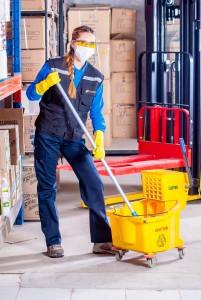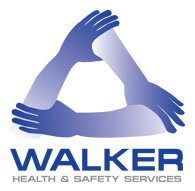Home / blog / 12 Tips For Deep Cleaning & Disinfecting To Protect Employees
by Walker Safety ·

12 Tips For Deep Cleaning & Disinfecting To Protect Employees
As COVID-19 restrictions begin to ease and employees return to the workplace, cleaning and disinfection within an organisation have never been more important. Maintaining good workplace hygiene is essential, especially in post coronavirus times. The health and safety of your staff and visitors are fundamental, so ensuring you have safe cleaning practices is key. What constitutes a deep clean? And what are the most effective tips for optimal hygiene cleaning? In this article, we share the very best ways to clean and disinfect your workplace to prevent the risk of spreading infection.
It’s important to understand the difference between deep cleaning and disinfecting the workplace. Deep cleaning removes germs, grime, dirt, and impurities. It doesn’t kill germs. However, by removing germs, it reduces the risk of contracting infection.
Disinfectants incorporate the use of chemicals to kill germs on a surface, rather than cleaning them. You can use this type of product after cleaning to further reduce the risk of infection.
Here are our essential tips for maintaining good hygiene cleaning in an organisation. Follow these tips to protect your employees and visitors’ safety and well-being.
Before performing any cleaning duties, you must undertake a risk assessment with your facility manager. This should include information on areas that are frequently touched as these will require special attention when deep cleaning. You can also note down air quality assessment to ensure you provide adequate ventilation for employees. Another thing to consider is social distancing, hand sanitiser stations and face masks for visitors. Your plan of action should aim to reduce the risk of COVID-19.
Public Health England suggests that hard surfaces and objects are regularly cleaned with a household detergent, followed by a disinfectant. Dirty surfaces or those which are regularly touched should be wiped with disposable paper roll or cloths and then discarded after every clean. You can also use disinfectant wipes which can be disposed of. Just ensure that the directions of use on each cleaning product are followed correctly. Here is more information on selecting the right cleaning products.
To ensure correct social distancing procedures are followed, you need to maximise the use of space within your business. This means you may need to move furniture, fixtures and fittings. Make a note of high traffic areas to determine if you can make alternative use of your space. For example, employees could be given their own stationery at their desk rather than having to walk to where the stationery supplies are kept.
Your cleaning staff should be highly trained in the correct cleaning practices. For instance, personal protective equipment (PPE) must be worn. The minimal amount of PPE is a disposable apron and gloves. Once used, these should be placed in a double bag for at least 72 hours and then disposed of in your normal rubbish. Surfaces can then be cleaned with detergent or soap and water, followed by a disinfectant. Cleaning staff should avoid splashing or spraying additional areas than the one they’re cleaning. Once completed, employees should wash their hands in warm soapy water for a minimum of 20 seconds.
If there is a higher risk of coronavirus within your business, such as a space becoming contaminated by an employee who has contracted COVID-19, then additional practices will need to be used. These include extra PPE to safeguard the cleaner’s face. If an infected person has come into contact with specific surfaces or has potentially contaminated high traffic spaces like toilets, corridors, and door handles, these should be deep cleaned and disinfected. Anything which cannot be cleaned adequately, such as laundry that is heavily contaminated, should be disposed of correctly.
Hard flooring should be deep cleaned and disinfected with disposable mop heads. Carpeted flooring and mats will require steam cleaning. Any upholstered furniture, including mattresses, which can’t be deep cleaned or disinfected should also be steam cleaned.
Rubbish should be handled as normal, apart from discarded cleaning items and where a potentially contaminated person/s are concerned. We’ve already mentioned that PPE and disposable cleaning items like cloths should be double-bagged and left for 72 hours before throwing away. If you have waste from potential COVID-19 cases and cleaning waste from this area, this should be double-bagged and kept in storage until test results are known. If the person tests negative, this waste can then be disposed of in general rubbish. For positive cases, you should arrange for local ‘Category B infectious waste’ collection. You’ll then be supplied with an orange clinical waste bag for your contaminated waste. Remember to keep all waste away from children.
In addition to implementing social distancing between employees, it’s also a good idea to limit the number of visitors on site. Continue to use virtual meetings where possible as this will reduce the risk of contamination, especially for staff members. If this isn’t feasible, try to stagger visitors throughout the day to limit the number of people inside the building. You can also attempt flexible workplace hours wherever possible. Concerning shared spaces, aim for flexibility with lunch and break times to decrease the number of people within shared areas. You can also install touchless entry into your building – some systems offer entry via phone, limiting the number of surfaces touched as well as making social distancing easier in high traffic areas.
If you need to slowly transition some of your employees back into the workplace, provide clear and concise updates to help manage your organisation. Continue to clean all areas, even if that means cleaning and disinfecting spaces which are hardly used. This will put your business in good stead for the future. Provide consistent updates to both internal staff and those working from home. Make sure everyone is aware of where PPE and hand sanitisers are kept.
It goes without saying that your employees need to understand the health and safety measures you implement within your company. Be prepared to communicate your workplace rules, whether this is via email or virtual meeting, in a calm manner. You’ll also need to be ready to answer their queries and offer support to those who may need extra guidance. It’s advisable to provide a space for employees to reach out with their questions, as well as using posters throughout your building to remind them of excellent hygiene, cleaning and social distancing recommendations.
Continue to review risk assessment and cleaning procedures to maintain hygiene standards and improve them. For example, install automatic doors rather than using traditional ones to reduce the frequency doors are touched. Furthermore, keep a continuous supply of disinfectant wipes, sanitisers, and masks. As an extra, you can offer unscented hand lotion to prevent dry hands. Ask everyone to spend five minutes clearing clutter from their workstations each day. Not only will this prevent waste from piling up, but it will also make surfaces easier to keep clean.
It’s never too early to start implementing safe cleaning practices in the workplace. Get your organisation ready for welcoming back your employees. Now you know what constitutes a deep clean and the best tips for hygiene cleaning, you can ensure your business maintains an excellent standard of workplace hygiene.
Contact us for further information.
Do you need commercial cleaning services to keep your workplace clean on a regular basis? At Perfect Clean, we provide expert commercial cleaning services for businesses of all types. Get in touch for a free quote today.
“This article was originally published in the blog of Perfect Clean LTD., a professional cleaning company based in Edinburgh, passionate and committed to keeping everyone safe with their exemplary health and safety practices.”
Signup to our email notifications to receive alerts when we publish new blogs. We promise not to spam your inbox, you will just get a short snappy intro to Health and Safety blogs we think you will love.
Contact
Walker Health and Safety Services Limited,
Suite 6, C1, Coalport House,
Stafford Court,
Stafford Park 1,
Telford,
Shropshire,
TF3 3BD
Telephone: 0845 834 0400
Fax: 0845 834 0401
Email: info@walkersafety.co.uk
